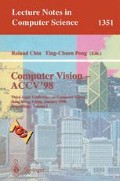Abstract
The bootstrap Problem of self-localization in indoor environments is a demanding task for initial localization and topological navigation. The ability to determine the position in an a priori known or already explored environment allows unsupervised use of mobile robots in environments such as private households. This paper presents our approach to identify a given set of known reference structures in a three-dimensional map of the local environment. This map is constructed from the data extracted by a line-based stereo camera system mounted on a mobile vehicle. We present the method used to identify objects and to compute the vehicle's position in a world frame.
The work presented in this paper was supported by the Deutsche Forschungsgemeinschaft as a past of an interdisciplinary research project on “Information Processing in Autonomous Mobile Robots” (SFB331).
Preview
Unable to display preview. Download preview PDF.
References
D. Burschka, C. Eberst, and C. Robl. Vision Based Model Generation for Indoor Environments. In ICRA97, pages 1940–1945, 1997.
D. Burschka and G. Färber. Active Controlled Exploration of 3D Environmental Models Based on a Binocular Stereo System. In ICAR97, pages 971–977, Monterey, California, USA, July 1997.
Oliver Faugeras. Three-Dimensional Computer Vision. Massachusetts Institute of Technology, The MIT Press, Cambridge, Massachusetts London, England, 1993.
A. Hauck and N. O. Stöffler. A hierarchic world model supporting video-based localisation, exploration and object identification. In 2. Asian Conference on Computer Vision, Singapore, 5.-8. Dec., pages (III) 176–180, 1995.
Gunter Magin, Achim Ruß, Darius Burschka, and Georg Färber. A dynamic 3D environmental model with real-time access functions for use in autonomous mobile robots. Robotics and Autonomous Systems, 14:119–131, 1995.
G. Stockman. Object recognition and localization via pose clustering. Computer Vision, 40:361–387, 1987.
Roger Y. Tsai. A Versatile Camera Calibration Technique for High Accuracy 3D Machine Vision Metrology Using Off-the-Shelf TV Cameras and Lenses. IEEE Transactions of Robotics and Automation, RA-3(4):323–344, August 1987.
Author information
Authors and Affiliations
Editor information
Rights and permissions
Copyright information
© 1997 Springer-Verlag Berlin Heidelberg
About this paper
Cite this paper
Burschka, D., Blum, S.A. (1997). Identification of 3D reference structures for video-based localization. In: Chin, R., Pong, TC. (eds) Computer Vision — ACCV'98. ACCV 1998. Lecture Notes in Computer Science, vol 1351. Springer, Berlin, Heidelberg. https://doi.org/10.1007/3-540-63930-6_113
Download citation
DOI: https://doi.org/10.1007/3-540-63930-6_113
Published:
Publisher Name: Springer, Berlin, Heidelberg
Print ISBN: 978-3-540-63930-5
Online ISBN: 978-3-540-69669-8
eBook Packages: Springer Book Archive

